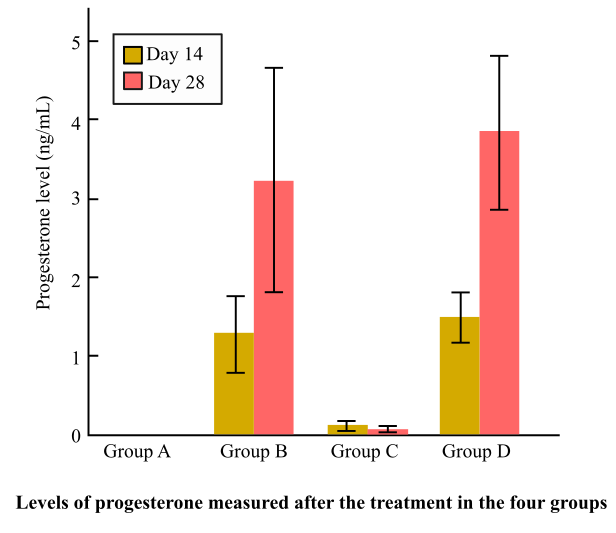
To review:
The sufficient and necessary stimulus required for ovulation in the female koala and possible cause of ovulation that could be removed through the experiment.
Introduction:
Most of the female mammals are spontaneous ovulators, meaning they release eggs in a cyclical fashion without an external stimulus. On the other hand, some of the female mammals like camels, koalas, and rabbits are reflex ovulators and require external stimulus to release their eggs. After postovulatory luteal phase, the levels of progesterone hormone increase; hence, in the given experiment, its levels have been measured in each of the groups.
It is already given as follows:
Experiment: The following four groups, each including nine female koalas were formed.
Group A: Artificial insemination of females with 1 milliliter (mL) of 0.9% sterile saline.
Group B: Artificial insemination of females with 1 mL of koala’s semen.
Group C: Urogenital sinus of females was artificially simulated with a glass rod.
Group D: Same treatment as in group C, which was followed by artificial insemination of females with 1 mL of koala’s semen.
After the above treatments, the progesterone levels were measured on 14 and 28 days from the blood samples. The mean standard deviations have also been shown in the following graph:

Want to see the full answer?
Check out a sample textbook solution
Chapter 42 Solutions
Life: The Science of Biology
- Which of the following is TRUE about the mechanism of sex determination? A) The product of the SRY gene converts the bipotential gonads into testes. B) The development of an ovary is conditioned by the presence of two X chromosomes. (C) Testosterone promotes the degeneration of the Mullerian duct. D. The ovary produces a Wolffian inhibition factor that causes the Wolffian duct to degenerate. E) The "feminization" of accessory sex orgarts is promoted by the ovary.arrow_forwardIf one follows 32 primary oocytes in an animal through their various stages of oogenesis, how many secondary oocytes would be formed? How many first polar bodies would be formed? How many ootids would be formed? If one follows 32 primary spermatocytes in an animal through their various stages of spermatogenesis, how many secondary spermatocytes would be formed? How many spermatids would be formed? Secondary oocytes First polar bodies Ootids Secondary Spermatocytes Spermatidsarrow_forwardWhich of the following is true about sex determination in mammals? Choose all possible answers. a.) The conversion of the genital ridge into the bipotential gonad requires the Sf1, Wt1, and Lhx9 transcription factors. b.) Even if one of the transcription factors mentioned in choice a (Sf1, Wt1, and Lhx9) will lose its function, the normal development of either male or female gonads will still push through. c.) Sry protein binds to the enhancer of the Sox9 gene and elevates expression of this key gene in the ovary-determining pathway. d.) β-catenin functions to initiate the ovarian pathway of development by activating the genes involved in granulosa cell differentiation. e.) Sf1 protein prevents the production of Sox9.arrow_forward
- What structural and biochemical changes do the spermatid undergo during spermiogenesis? How do these changes help the future gamete in performing its role in fertilization?arrow_forwardExplain the chromosomal and genetic control of sex determination in mammals. Clearly establish the difference between the primary and the secondary phases.arrow_forwardDiscuss the mechanism of action of the oxytocin? How does it facilitates uterine contraction especially to birthing mothers?arrow_forward
- What structural and biochemical changes does the spermatid undergo during permiogenesis?How do these changes help the future gamete in performing its role in fertilization?arrow_forwardWhat are the general characteristics of sexual reproduction in humans and other vertebrates that are associated with continuous production of many sperm cells but intermittent, finite production of egg cells?arrow_forwardWhy does corpus luteum stay active throughout pregnancy and in the absence of fertilization, is active only for 10-12 days?arrow_forward
- Shown here are graphs that plot the percentage of fertilizedeggs containing males against the atmospheric temperatureduring early development in (a) snapping turtles and (b) mostlizards. Interpret these data as they relate to the effect oftemperature on sex determination.arrow_forwardBased on the schematic below, illustrating the control of the hypothalamus and the pituitary gland by the ovarian hormones, how would you design a hormonal female contraceptive that keeps secretion of FSH and LH low in order to prevent ovulation?arrow_forwardesis Evaluate the following statements and choose the incorrect ones: Granulosa cells secrete progesterone to form zona pellucida around the primary oocyte. Spermatogonia divide by mitosis to give two identical cells. One of these cells replenishes the spermatogonia. Sertoli cells affect the developing sperm. Primordial germ cells colonise the cortex of the primordial gonad and replicate by mitosis. I. II. III. IV. Statements Il and III Statements IV and II Statements I and III Statements Il and Iarrow_forward
 Human Heredity: Principles and Issues (MindTap Co...BiologyISBN:9781305251052Author:Michael CummingsPublisher:Cengage Learning
Human Heredity: Principles and Issues (MindTap Co...BiologyISBN:9781305251052Author:Michael CummingsPublisher:Cengage Learning
